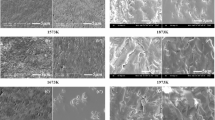Abstract
In order to study the deformation and fracture mechanism of machinable mica glass ceramics under different loading modes, quasi-static uniaxial tensile and compression experiments are designed and analyzed based on the obtained quasi-static stress-strain curves at different strain rates, the macroscopic and microscopic fracture morphology of the samples and the nano-indentation experiment. The results show that mica glass ceramics are basically elastic brittle bodies. A very short “softening” section before the compression fracture is observed. There is a significant SD (tensile and compressive strength difference) effect, and the ratio of compressive to tensile strength is 14. The fracture mechanism of mica glass ceramics is related to the loading mode. The fracture mechanism is normal tensile fracture perpendicular to the loading axis under tensile loading. Under compressive loading, there is a mixed mode of distensile splitting and local shear failure. The microcrack is preferentially nucleated and extends to the weak interface at the junction of two phases, and the critical nucleation load is about 20 mN. The energy consumption mechanism of crack initiation and propagation at the weak interface and cleavage steps are the reason for the softening of the compression end curve.












Similar content being viewed by others
REFERENCES
Abdel-Hameed, S.A.M., Ismail, N., and Youssef H.F., Preparation and characterization of mica glass-ceramics as hydrogen storage materials, Int. J. Hydrogen Energy, 2017, vol. 42, no. 10, pp. 6829–6839. https://doi.org/10.1016/j.ijhydene.2016.11.190
Pinchuk, N., Parkhomey, O., and Sych, O., In vitro investigation of bioactive glass-ceramic composites based on biogenic hydroxyapatite or synthetic calcium phosphates, Nanoscale Res. Lett., 2017, vol. 111, no. 12, pp. 1–8. https://doi.org/10.1186/s11671-017-1895-1
Gali, S., Ravikumar, K., and Murthy, B.V.S., Zirconia toughened mica glass ceramics for dental restorations, Dent. Mater., 2018, vol. 34, no. 3, pp. e36–e45. https://doi.org/10.1016/j.dental.2018.01.009
Fuertes, V., Cabrera, M.J., and Seores, J., Enhanced wear resistance of engineered glass-ceramic by nanostructured self-lubrication, Mater. Des., 2019, vol. 168, pp. 1–10. https://doi.org/10.1016/j.matdes.2019.107623
Rahaman Molla, A. and Basu, B., Microstructure, mechanical, and in vitro properties of mica glass-ceramics with varying fluorine content, J. Mater. Sci. Mater. Med., 2009, vol. 20, pp. 869–882. https://doi.org/10.1007/s10856-008-3643-7
Bai, J. and Chaysuwan, D., Nucleation, crystallization and characterization of mica-based glass-ceramics with fluorapatite, Adv. Mater. Res., 2014, vol. 936, pp. 164–169. www.scientific.net/AMR.936.164.
Marada, T., Rodrigues, A.C., and Furtado, R., Polishing for glass ceramics: Which protocol?, J. Prosthodont. Res., 2014, vol. 58, no. 3, pp. 160–170. https://doi.org/10.1016/j.jpor.2014.02.001
Ma, L., Yu, A.-b., and Gu, L.-ch., Mechanism of compound fracture and removal in grinding process for low-expansion glass ceramics, Int. J. Adv. Manuf. Tech., 2017, vol. 91, no. 5, pp. 2303–2313. https://doi.org/10.1007/s00170-016-9915-3
Hing, P. and McMillan, P.W., The strength and fracture properties of glass-ceramics, J. Mater. Sci., 1973, vol. 8, no. 7, pp. 1041–1048. https://doi.org/10.1007/BF00756636
Fraçois, D., Pineau, A., and Zaoui, A., Damage and fracture of non-metallic naterials, Mech. Behaviour Mater., 2012, vol. 191, pp. 551–635. https://doi.org/10.1007/978-94-007-4930-6_10
Fischer-Cripps, A.C., Shear driven damage and internal friction in indentation loading of a glass-ceramic, Fract. Mech. Ceram., 2005, vol. 14, pp. 113–120. https://doi.org/10.1007/978-0-387-28920-5_10
Fischer-Cripps, A.C., Role of internal friction in indentation damage in a mica-containing glass-ceramic, J Am. Ceram. Soc., 2001, vol. 84, no. 11, pp. 2603–2606. https://doi.org/10.1111/j.1151-2916.2001.tb01060.x
Lawn, B.R., Wilshaw, T.R., Barry, T.I., and Morrell, R., Hertzian fracture of glass ceramics, J. Mater. Sci., 1975, vol. 10, no. 1, pp. 179–182. https://doi.org/10.1007/BF00541049
Cai, H., Marion, A., and Kalceff, S., Deformation and fracture of mica-containing glass-ceramics in Hertzian contacts, J. Mater. Res., 1994, vol. 9, no. 3, pp. 762–770. https://doi.org/10.1557/JMR.1994.0762
Reimanis, I.E. and Schaut, R.A., Hertzian testing to obtain flaw distributions in high strength glasses and glass-ceramics, J Am. Ceram. Soc., 2016, vol. 99, no. 11, pp. 3712–3718. https://doi.org/10.1111/jace.14407
Chen, J., Xie, Zh., and Wei, S., Enhanced mechanical properties of machinable mica glass ceramics at cryogenic temperatures, MRS Commun., 2016, vol. 6, no. 4, pp. 1–5. https://doi.org/10.1557/mrc.2016.59.
Zhang, Z.F. and Eckert, J., Unified tensile fracture criterion, Phys. Rev. Lett., 2005, vol. 94, no. 9, pp. 1–4. https://doi.org/10.1103/PhysRevLett.94.094301
Qu, R.T., Eckert, J., and Zhang, Z.F., Tensile fracture criterion of metallic glass, J. Appl. Phys., 2011, vol. 109, no. 8, pp. 1–12. https://doi.org/10.1063/1.3580285
Chen, Y., Jiang, M.Q., and, Wei, Y.J., Failure criterion for metallic glasses, Philos. Mag., 2011, vol. 91, no. 36, pp. 4536–4554. https://doi.org/10.1080/14786435.2011.613859
Johnson, K.L., The contribution of micro/nano-tribology to the interpretation of dry friction, Proc. Inst. Mech. Eng., 2000, vol. 214, no. 1, pp. 11–22. https://doi.org/10.1243/0954406001522778
Author information
Authors and Affiliations
Corresponding author
Ethics declarations
The authors declare that they have no conflicts of interest.
Rights and permissions
About this article
Cite this article
Hui Yu, Li, W., Zhu, Wg. et al. Study of Fracture Mechanism of Machinable Mica Glass-Ceramics under Quasi-Static Conditions. Glass Phys Chem 45, 555–564 (2019). https://doi.org/10.1134/S1087659620010083
Received:
Revised:
Accepted:
Published:
Issue Date:
DOI: https://doi.org/10.1134/S1087659620010083




